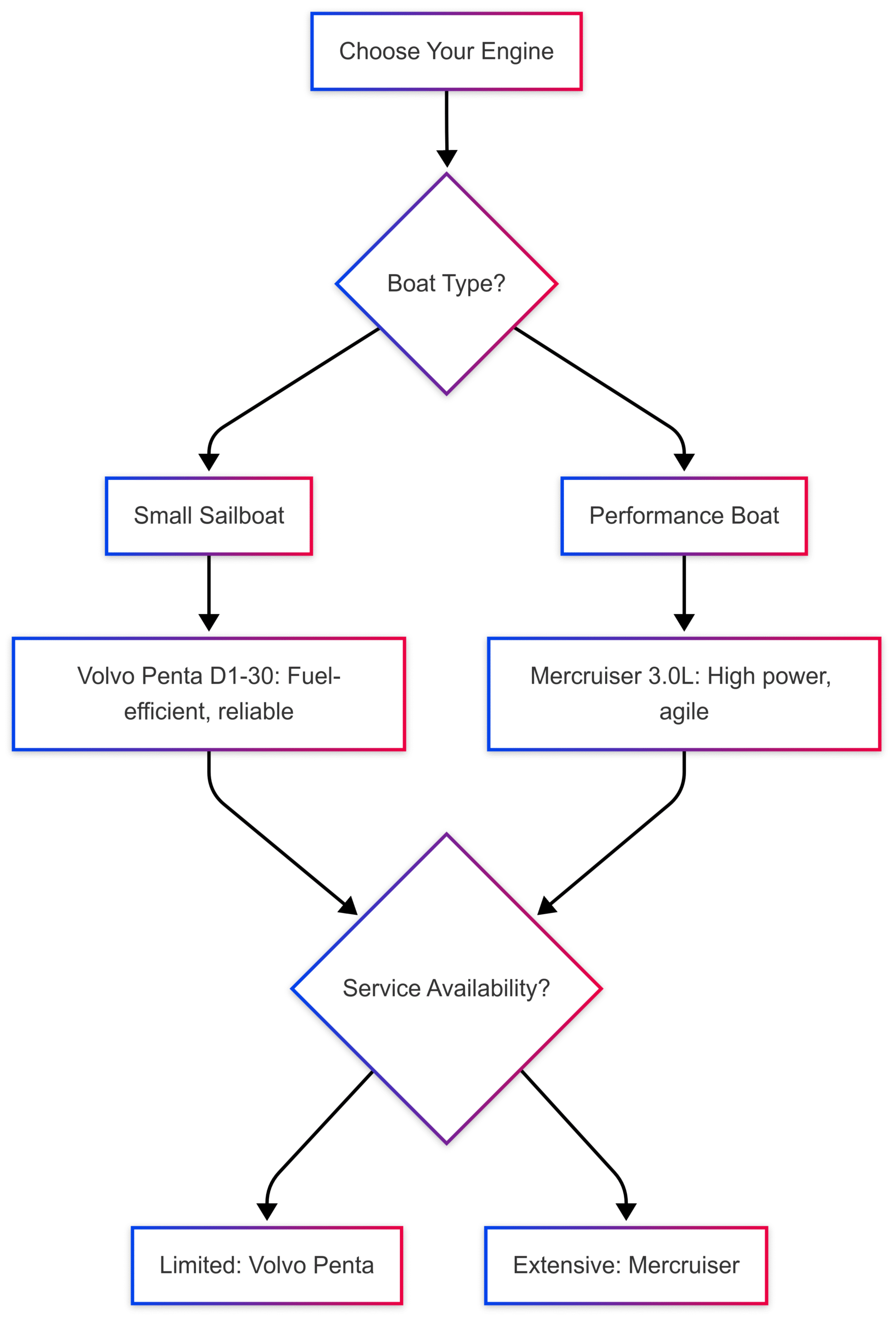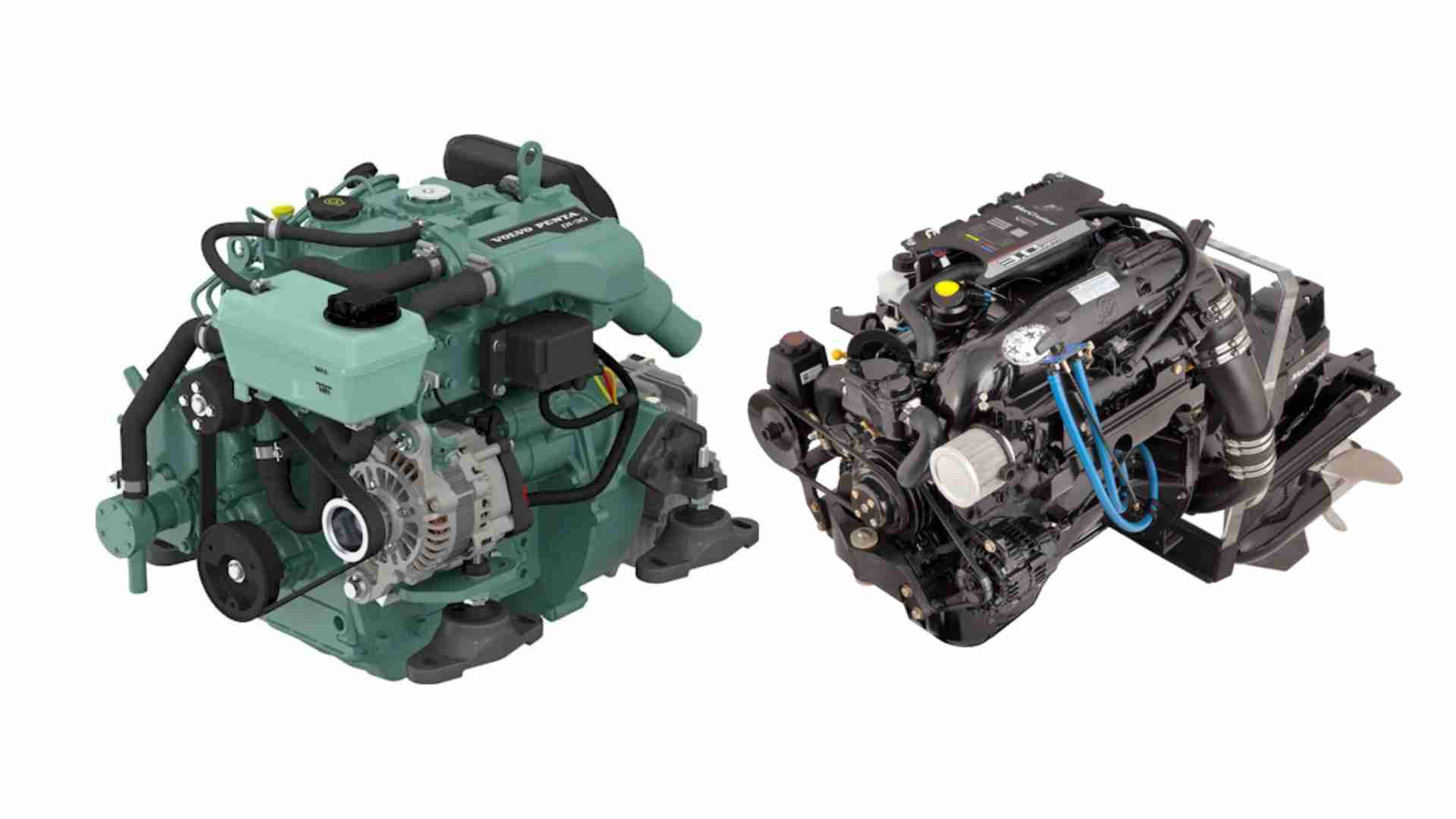Volvo Penta 30 vs. Mercruiser 30: Marine Power Duel
Compare Volvo Penta D1-30 vs. Mercruiser 3.0L marine engines. Explore performance, fuel efficiency, durability, and maintenance to choose the best for your boat.
The marine engine market is a battleground where performance, reliability, and efficiency determine the winner for boat owners. Two titans, the Volvo Penta D1-30 and the Mercruiser 3.0L, stand out for their unique strengths. The Volvo Penta D1-30, a diesel engine, is celebrated for its fuel efficiency and robust reliability, ideal for long-distance cruisers. In contrast, the Mercruiser 3.0L, a gasoline-powered engine, delivers superior horsepower and acceleration, appealing to performance-driven boaters. This article dives deep into their specifications, performance, fuel efficiency, durability, maintenance, and real-world user insights to help you decide which engine powers your next aquatic adventure.
Engine Specifications
Understanding the technical details of these engines is crucial for making an informed choice. Below is a detailed comparison of their specifications:
| Feature | Volvo Penta D1-30 | Mercruiser 3.0L |
|---|---|---|
| Engine Type | Diesel, 3-cylinder, in-line | Gasoline, 4-cylinder, in-line |
| Horsepower | 28.4 hp at 3,200 RPM | 135 hp at 4,800 RPM |
| Displacement | 1.1 liters | 3.0 liters |
| Fuel System | Common-rail direct injection | Carbureted or Multi-Port Fuel Injection (MPI) |
| Cooling System | Freshwater cooling (standard) | Raw water or optional freshwater cooling |
| Weight | Approx. 322 lbs (146 kg) | Approx. 635 lbs (288 kg) |
| Drive Options | Saildrive or shaft drive | Alpha One or Bravo Three outdrive |
| Price (Approximate) | $12,000–$15,000 (new, base model) | $8,000–$12,000 (new, base model) |
Volvo Penta D1-30
The Volvo Penta D1-30 is a compact, lightweight diesel engine designed for smaller sailboats and powerboats requiring auxiliary power. Its 3-cylinder configuration and common-rail fuel injection system ensure efficient fuel delivery and smooth operation. With a displacement of 1.1 liters, it produces 28.4 horsepower, making it suitable for vessels up to 30 feet. Its freshwater cooling system enhances durability by reducing corrosion, especially in saltwater environments.
Mercruiser 3.0L
The Mercruiser 3.0L, a gasoline engine, is built for performance-oriented boats, such as runabouts and small cruisers. Its 4-cylinder design and 3.0-liter displacement deliver a robust 135 horsepower, ideal for watersports and faster cruising. Available with either a carbureted or MPI fuel system, it offers flexibility for different performance needs. The Alpha One and Bravo Three outdrives provide agile handling, with the Bravo Three’s dual-propeller design enhancing thrust and maneuverability.
Performance: Thrust and Torque
Performance is a critical factor in choosing a marine engine, as it directly impacts your boating experience. The Mercruiser 3.0L’s 135 horsepower significantly outpaces the Volvo Penta D1-30’s 28.4 horsepower, making it the go-to choice for boaters prioritizing speed and acceleration. Its higher torque output ensures quick planing and responsive handling, ideal for waterskiing, wakeboarding, or high-speed cruising. For example, a 22-foot runabout with a Mercruiser 3.0L can achieve top speeds of 35–40 knots, depending on load and conditions.
The Volvo Penta D1-30, while less powerful, excels in delivering consistent low-end torque, perfect for sailboats or displacement hulls that prioritize steady cruising over speed. Its diesel engine provides smooth power delivery, ensuring reliable performance for long-distance voyages. For a 28-foot sailboat, the D1-30 offers ample power for maneuvering in harbors or cruising at 5–7 knots.
Performance Comparison Chart

This chart illustrates the Mercruiser’s dominance in high-speed applications and the Volvo Penta’s strength in steady, torque-driven performance.
Fuel Efficiency: Cruising Range and Environmental Impact
Fuel efficiency is a top priority for boaters, especially those embarking on extended trips. Diesel engines like the Volvo Penta D1-30 typically outperform gasoline engines in fuel economy. The D1-30 consumes approximately 0.5–0.7 gallons per hour (GPH) at cruising speeds of 2,500–3,000 RPM, allowing a 30-foot sailboat with a 20-gallon tank to achieve a range of 200–250 nautical miles. Its common-rail injection system optimizes fuel burn, reducing emissions and operational costs.
The Mercruiser 3.0L, while less fuel-efficient, still performs admirably for a gasoline engine. At a cruising speed of 3,000 RPM, it consumes around 7.5 GPH, though this can increase to 12–15 GPH at wide-open throttle (WOT). For a 22-foot runabout with a 40-gallon tank, this translates to a range of 80–100 nautical miles at cruising speed. The optional MPI system improves fuel efficiency slightly compared to the carbureted version, but it cannot match the diesel’s economy.
Fuel Efficiency Table
| Engine | Cruising Fuel Consumption (GPH) | Range (20-gal tank, nm) | Range (40-gal tank, nm) |
|---|---|---|---|
| Volvo Penta D1-30 | 0.5–0.7 | 200–250 | 400–500 |
| Mercruiser 3.0L | 7.5 (MPI: ~6.5) | 40–50 | 80–100 |
The Volvo Penta D1-30 is the clear winner for fuel-conscious boaters or those planning long-distance cruises, while the Mercruiser 3.0L suits shorter, performance-oriented trips where fuel availability is not a concern.
Durability: Withstanding the Marine Environment
Marine engines face harsh conditions—saltwater, humidity, and constant vibrations demand robust construction. The Volvo Penta D1-30’s diesel design and freshwater cooling system provide excellent corrosion resistance, extending its lifespan in saltwater environments. Its robust 3-cylinder block and high-quality materials ensure reliability, with many users reporting 2,000+ hours of operation with minimal issues. For instance, a user on a boating forum noted running a Volvo Penta outdrive with 90% water in the gear lube for three seasons without failure, highlighting its durability.
The Mercruiser 3.0L, while durable, is more susceptible to corrosion if equipped with raw water cooling, particularly in saltwater. The optional freshwater cooling system mitigates this, but it increases costs. The Alpha One outdrive, while reliable, has a reputation for issues like worn bushings or leaking seals if not maintained properly. However, the Bravo Three outdrive, with its dual-propeller design, offers enhanced durability and thrust, rivaling Volvo Penta’s Duoprop system. Users report Mercruiser engines lasting 800–2,000 hours with regular maintenance, though outdrive repairs can be more frequent than with Volvo Penta.
Durability Factors

This chart highlights the Volvo Penta’s edge in corrosion resistance and standard cooling features, while the Mercruiser requires careful maintenance to match its longevity.
Maintenance and Service: Ease of Ownership
Maintenance is a critical consideration, as it affects both cost and downtime. The Volvo Penta D1-30 is designed for ease of maintenance, with its raw water impeller mounted on the engine, allowing for quick replacement in about 5 minutes. Its cartridge-style oil filter minimizes mess, and the Electronic Vessel Control (EVC) system simplifies diagnostics and maneuvering. However, parts can be expensive, and service networks are less widespread, especially in remote areas. A user in Slovenia noted that Volvo Penta parts were harder to source locally compared to Mercruiser.
The Mercruiser 3.0L benefits from a vast service network and readily available parts, making it easier to find mechanics and components. However, tasks like impeller replacement on the Alpha One outdrive are more labor-intensive, requiring the outdrive to be partially disassembled. The Bravo Three outdrive improves on this, with an engine-mounted impeller similar to Volvo Penta. Mercruiser parts are generally cheaper, but some users report more frequent repairs, such as issues with leaking sea pumps or IAC failures.
Maintenance Comparison Table
| Aspect | Volvo Penta D1-30 | Mercruiser 3.0L |
|---|---|---|
| Impeller Replacement | Engine-mounted, ~5 min | Alpha One: Outdrive-mounted, ~30 min |
| Parts Availability | Moderate, higher cost | High, lower cost |
| Service Network | Limited in some regions | Extensive, widely available |
| Common Issues | Rare, but costly repairs | More frequent, but cheaper repairs |
Real-World Insights: Boater Experiences
Boating forums provide valuable insights into real-world experiences. Many users praise the Volvo Penta for its smooth shifting (thanks to its cone clutch) and reliability. A user with twin Volvo Penta 5.0 GXi engines found them easier to maintain and more durable than Mercruiser, even in saltwater conditions. However, others noted that Volvo Penta parts are pricier and harder to source, with one user reporting an $11,000 cost for a replacement outdrive in Europe.
Mercruiser owners appreciate the brand’s extensive support network and affordability. A user with a Mercruiser 5.0 MPI on a 2007 Regal 2250 praised its reliability and ease of service, though some reported issues with Alpha One outdrives, such as clunky shifting or seal leaks. The Bravo Three outdrive received high marks for durability and performance, often considered comparable to Volvo Penta’s Duoprop.
Choosing the Right Engine for Your Boat
The choice between the Volvo Penta D1-30 and Mercruiser 3.0L depends on your boating needs:
- Boat Size and Use: The Mercruiser 3.0L is ideal for larger boats (20–26 feet) or performance-oriented activities like watersports. The Volvo Penta D1-30 suits smaller vessels (up to 30 feet) or sailboats needing reliable auxiliary power.
- Fuel Considerations: If fuel efficiency and range are priorities, the Volvo Penta’s diesel efficiency is unmatched. For shorter trips where gasoline is readily available, the Mercruiser is more practical.
- Maintenance and Support: Mercruiser’s widespread parts and service network is a significant advantage in regions with limited Volvo Penta support. However, Volvo Penta’s easier maintenance tasks appeal to DIY boaters.
- Budget: The Mercruiser 3.0L is generally more affordable upfront and for repairs, while the Volvo Penta D1-30 offers long-term savings through fuel efficiency and durability.
Decision Flowchart

This flowchart guides boaters through key decision points based on vessel type and service availability.
Pricing and Value
The Volvo Penta D1-30’s higher upfront cost ($12,000–$15,000) reflects its diesel construction and advanced features like EVC. Its long-term value lies in fuel savings and durability, especially for frequent cruisers. The Mercruiser 3.0L, priced at $8,000–$12,000, offers better value for budget-conscious boaters or those prioritizing performance over efficiency. Repair costs for Mercruiser are typically lower, but frequent maintenance may offset initial savings.
Conclusion
The Volvo Penta D1-30 and Mercruiser 3.0L are both exceptional marine engines, each excelling in different areas. The Volvo Penta D1-30 is the champion for fuel efficiency, reliability, and ease of maintenance, making it ideal for sailboats and long-distance cruisers. The Mercruiser 3.0L shines with its high horsepower, affordability, and extensive support network, perfect for performance-driven boaters. Your choice depends on your boating style, vessel size, and access to service. Whether you seek the enduring efficiency of Volvo Penta or the powerful thrust of Mercruiser, both engines promise unforgettable adventures on the water.
Happy Boating!
Share Volvo Penta 30 vs. Mercruiser 30: Marine Power Duel with your friends and leave a comment below with your thoughts.
Read VHF Marine Radio Antenna: All you need to Know until we meet in the next article.






